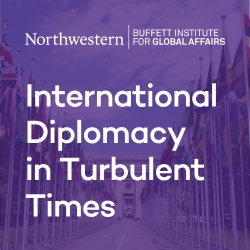The Colombian Paradox: Histories of War and Peace | Buffett Lecture

When:
Wednesday, January 22, 2025
12:30 PM - 1:45 PM CT
Where: Second Floor, 720 University Place, Evanston, IL
Audience: Faculty/Staff - Student - Public - Post Docs/Docs - Graduate Students
Contact:
Buffett Institute for Global Affairs
(847) 467-2770
buffettinstitute@northwestern.edu
Group: Roberta Buffett Institute for Global Affairs
Category: Global & Civic Engagement
Description:
The Buffett Institute for Global Affairs has launched a yearlong initiative focused on international diplomacy in turbulent times. The series will explore key moments in recent diplomacy through lunchtime lectures throughout the winter quarter on the landmark peace processes of the last few decades. Lunch will be provided beginning at 12:15 p.m.
On November 26, 2016, the longest internal armed conflict in the Western hemisphere came to an official end. On the stage of a historic theater in downtown Bogotá, Colombia's President Juan Manuel Santos (2010–2018) shook hands with Timochenko, the commander-in-chief of the Revolutionary Armed Forces of Colombia (FARC), the oldest and largest guerrilla army in the Americas. Although the ceremony ratified the peace accords that the parties had negotiated for four years in Havana, Cuba, the treaty has not brought peace to the South American country. This talk explores the factors of persistence of the armed conflict in Colombia in the context of an apparent paradox between the formalities of a strong constitutional order, which stands out in a continent with a history of military coups and dictatorships, and the realities of political domination. It proposes to understand the limits of the peace accords not only as failures of implementation, but against the backdrop of a process of nation-state formation that has unfolded through multiples forms of internal colonialism and with every cycle of war and peace renews itself under new modalities of violence.
Lina Britto, Associate Professor of History at Northwestern’s Weinberg College of Arts & Sciences, will discuss the Colombian peace process.
Please note that 720 University Place is not an ADA-accessible space. Increasing physical access to buildings and facilities is a goal of the University, but not all buildings and venues have been updated.